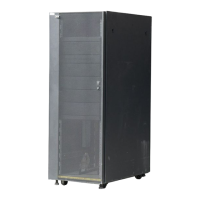• Add 120 ppm of Nalco 3DT-199 to achieve 40 ppm of azole concentration. The amount of inhibitor
dosage is calculated based on the volume of the makeup water.
• Conrm azole residual using Nalco azole test kit.
Refreshing the water
Situations might arise where the water must be refreshed (for example, the system must be cleaned and
the biocide and corrosion inhibitor is added again). To refresh the water, use one of the two following
procedures:
If you prefer that no water goes down the sanitary sewer, use the following procedure:
1. Remove the inline 50 μm lter from the lter housing.
2. Insert new deionization cartridges into the canisters and bypass some of the water through the
deionizing cartridges until the resistivity of the water increases above 1 MΩ.cm. During this period, the
systems and cooling system can be left on and be fully functional.
3. Stop the bypassing of the water flow through the deionizing lter and add a new or cleaned 50 μm
lter to the inline lter housings.
4. Add one of the following biocides:
• 100 parts per million (ppm) of Nalco H-550 (glutaraldehyde)
• 200 ppm of Nalco 73500 (glutaraldehyde)
• 100 ppm of Nalco 77352 (isothiazolone)
The choice of biocide depends on the expected microbiological material in the cooling loop.
Glutaraldehyde biocide is more effective against anaerobic bacteria. Isothiazolone is more effective
against aerobic bacteria, fungi, and algae. When in doubt, use the isothiazolone biocide.
5. Circulate for 30 minutes.
6. Add 120 ppm of Nalco 3DT-199 to achieve 40 ppm of azole concentration.
7. Circulate for 30 minutes.
8. Conrm azole residual using Nalco azole test kit.
If the water can be poured down the sanitary sewer, use the following procedure:
1. Pour the water down the drain with the permission of the local municipality.
2. Fill the system by using one of the following procedures:
• Systems less than 75.7 liters (20 gallons): “Initial treatment for systems smaller than 75.7 liters (20
gallons)” on page 164.
• Systems larger than 75.7 liters (20 gallons): “Initial treatment for systems larger than 75.7 liters (20
gallons)” on page 166.
Moving or storing the system
If you need to move your system or put it into storage, the water in the system must be drained. You can
drain the water in one of two ways:
• The water can be deionized to a purity corresponding to resistivity greater than 0.1 MΩ.cm and then can
be poured down any municipal drain.
• The water can be poured down a sanitary drain with the permission of the local municipality.
Disposal of water and cartridges
The deionizing cartridges must be disposed off in accordance with local municipality ordinances.
IBM is not responsible for the disposal of water. You are responsible for determining the local regulations
that govern the disposal of water.
168
Power Systems: Racks and rack features

